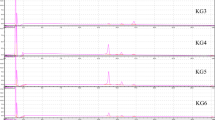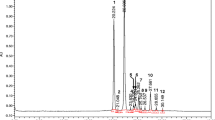Abstract
Anthocyanin pigments in black soybean (Glycine max (L.) Merr.) varieties as Tawonkong (TW) and Geomjeongkong-2 (G2) were identified to evaluate their potentials as nutritional function, natural colorant or functional foods. Anthocyanin extraction was conducted with acidified methanol with 0.1 M HCl (85:15, v/v). Identification of anthocyanin was conducted by comparison with purified standards by HPLC and mass spectrometry (MS). G2 showed six different types of pigments by HPLC, whereas TW showed seven pigments. Three major anthocyanins (peaks 1, 3, 4) were detected in both varieties and peak 1 was characterized as delphinidin-3-O-β-D-glucoside, peak 3 as cyanidin-3-O-β-D-glucoside (C3G), and peak 4 as petunidin-3-O-β-D-glucoside by comparison of chromatographic properties with authentic standards and MS. Minor peaks 5, 6 and 7 in TW were tentatively identified as pelargonidin-3-O-glucoside, pelargonidin-3-O-(6″-malonylglucoside) and cyanidin on the basis of MS. MS with major ions at 287 and 449 of peak 2 were exactly same as those of peak 3 meaning that peak 2 has cyanidin and other hexose different from glucose. After acid hydrolysis of fractioned peak 2, HPLC showed the hexose as galactose, and peak 2 was identified as C3Glactose. The most abundant anthocyanin in black soybean (Glycine max (L.) Merr.) was C3G and G2 showed the higher amount of total anthocyanins than TW (p < 0.001).

Similar content being viewed by others
References
Abdel-Aal E-SM, Young JC, Rabalski I (2006) Anthocyanin composition in black, blue, pink, purple, and red cereal grains. J Agric Food Chem 54:4696–4704
Bettini V, Fiori A, Martino R, Mayellaro R, Ton P (1985) Study of the mechanism whereby anthocyanosides potentiate the effect of catecholamines on coronary vessels. Fitoterapia 2:67–72
Bridle P, Timberlake CF (1997) Anthocyanins as natural foods colours-selected aspects. Food Chem 58:103–109
Choung MG, Baek IY, Kang ST, Han WY, Shin DC, Moon HP, Kang KW (2001) Isolation and determination of anthocyanins in seed coats of black soybean (Glycin max (L.) Merr.). J Agric Food Chem 49:5848–5851
Choung MG, Choi BR, An YN, Chu YH, Cho YS (2003) Anthocyanin profile of Korean cultivated kidney bean. J Agric Food Chem 51:7040–7043
Dao LT, Takeota GR, Edwards RH, JdeJ B (1998) Improved method for the stabilization of anthocyanins. J Agric Food Chem 46:3564–3569
Francis FJ (2000) Anthocyanins and betalains composition: composition and applications. Cereal Foods World 45:208–213
Hyun JW, Chung HS (2004) Cyanidin and malvidin from Oryza sativa cv. Heug**jubyeo mediate cytotoxicity against human monocytic leukemia cells by arrest of G2/M phase and induction of apoptosis. J Agric Food Chem 52:2213–2217
Kamei H, Kojima T, Hasegawa M, Koide T, Umeda T, Yukawa T, Terabe K (1995) Suppression of tumor cell growth by anthocyanins in vitro. Cancer Invest 13:590–594
Kim MK, Kim H, Koh K, Kim HS, Lee YS, Kim YH (2008) Identification and quantification of anthocyanin pigments in colored rice. Nutr Res Prac 2:46–49
Kuroda C, Wada M (1933) The colouring matter of kuno-mame. Proc Imper Acad 9:17
Lee JH, Kang NS, Shin SO, Shin SH, Lim SG, Suh DY, Baek IY, Park KY, Ha YJ (2009) Characterization of anthocyanins in the black soybean (Glycine max L.) by HPLC-DAD-ESI/MS analysis. Food Chem 112:226–231
Macz-Pop GA, Rivas-Gozalo JC, Perez-Alonso JJ, Gonzalez-Paramas AM (2006) Natural occurrence of free anthocyanin aglycones in beans (Phaseolus vulgaris L.). Food Chem 94:448–456
Mazza G, Gao L (2005) Blue and purple grains. In: Abdel-Aal E-SM, Peter PJ (eds) Specialty Grains for Food and Feed. American Association of Cereal Chemists, St. Paul, pp 45–67
Moreno YS, Sanchez GS, Hernandez DR, Lobato NR (2005) Characterization of anthocyanin extracts from maize kernels. J Chromatogr Sci 43:483–487
Nam SH, Choi SP, Kang MY, Koh HJ, Kozukue N, Friedman M (2006) Antioxidative activities of bran from twenty one pigmented rice cultivars. Food Chem 94:613–620
Philpott M, Gould KS, Lim C, Ferguson LR (2006) In situ and in vitro antioxidant activity of sweetpotato anthocyanins. J Agric Food Chem 54:1710–1715
Satue-Gracia M, Heinonen IM, Frankel EN (1997) Anthocyanins as antioxidants on human low-density lipoprotein and lecithinliposome system. J Agric Food Chem 45:3362–3367
Schou SA (1927) Light absorption of several anthocyanins. Helv Chim Acta 10:907–915
Stocker R, O’Halloran RO (2004) Dealcoholized red wine decreases atherosclerosis in apolipoprotein E gene-deficient mice independently of inhibition of lipid peroxidation in the artery wall. Am J Clin Nutr 79:123–130
Strack D, Wray V (1989) Methods in Plant Biochemistry. Academic, London
Todd JJ, Vodkin LO (1993) Pigmented soybean (Glycine max) seed coats accumulate proanthocyanidins during development. Plant Physiol 102:663–670
Tsuda T, Horio F, Osawa T (2002) Cyanidin 3-O-β-glucoside suppresses nitric oxide production during a zymosan treatment in rats. J Nutr Sci Vitaminol 48:305–310
Tsuda T, Horio F, Uchida K, Aoki H, Osawa T (2003) Dietary cyanidin 3-O-β-D-glucoside-rich purple corn color prevents obesity and ameliorates hyperglycemia. J Nutr 133:2125–2130
Waterhouse AL (1995) Wine and heart disease. Chem Ind 338–341
Yoshida K, Sato Y, Okuno R, Kameda K, Isobe M, Kondo T (1996) Structural analysis and measurement of anthocyanin from colored seed coats of Vigna, Phaseolus, and Glycine legumes. Biosci Biotechnol Biochem 60:589–593
Yoshikura K, Hamaguchi Y (1969) Anthocyanins of the black soybean. Eiyo To Shokuryo 22:367
Zhao C, Giusti MM, Malik M, Moyer MP, Magnuson BA (2004) Effects of commercial anthocyanin-rich extracts on colonic cancer and nontumorigenic colonic cell growth. J Agric Food Chem 52:6122–6128
Acknowledgment
This study was supported by the research grant from Soonchunhyang University.
Author information
Authors and Affiliations
Corresponding author
Rights and permissions
About this article
Cite this article
Koh, K., Youn, J.E. & Kim, HS. Identification of anthocyanins in black soybean (Glycine max (L.) Merr.) varieties. J Food Sci Technol 51, 377–381 (2014). https://doi.org/10.1007/s13197-011-0493-y
Revised:
Accepted:
Published:
Issue Date:
DOI: https://doi.org/10.1007/s13197-011-0493-y




